Industry News, trenchless people, trenchless projects
Robbins XRE completes the First TBM-driven Tunnel in Albania
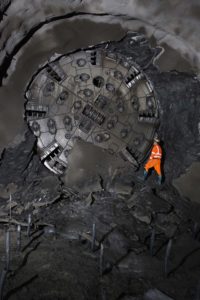 On May 3, 2018 a 6.2 m (20.3 ft) diameter Robbins Crossover (XRE) TBM broke through into an underground chamber, marking the completion of the first TBM-driven tunnel in Albania. The TBM, operated by contractor Limak, was also the first Crossover machine to operate in Europe, and bored through geology including ophiolite, sandstone, breccia and siltstone flysch.
On May 3, 2018 a 6.2 m (20.3 ft) diameter Robbins Crossover (XRE) TBM broke through into an underground chamber, marking the completion of the first TBM-driven tunnel in Albania. The TBM, operated by contractor Limak, was also the first Crossover machine to operate in Europe, and bored through geology including ophiolite, sandstone, breccia and siltstone flysch.
“The cutterhead and cutters have achieved outstanding performance,” said Engin Gur, TBM Manager for Limak. The TBM achieved rates as high as 648 m (2,126 ft) per month in April 2018, and as much as 37.4 m (122.7 ft) in one day. The Crossover TBM did not encounter high-pressure water and was thus used in hard rock Double Shield mode throughout tunneling.
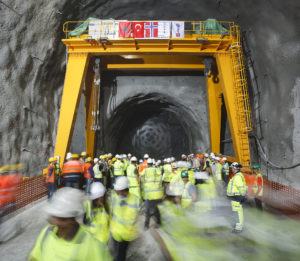 “The TBM performed very well, as did a Robbins-supplied adit conveyor that operated in a 180-degree continuous curve. It was impressive,” said Max Walker, Robbins Field Service Superintendent. Several field service personnel remained onsite throughout operation of the TBM to provide guidance and trouble-shooting.
“The TBM performed very well, as did a Robbins-supplied adit conveyor that operated in a 180-degree continuous curve. It was impressive,” said Max Walker, Robbins Field Service Superintendent. Several field service personnel remained onsite throughout operation of the TBM to provide guidance and trouble-shooting.
The machine was launched in November 2016 following Onsite First Time Assembly (OFTA), which enabled the machine to be initially assembled at the jobsite. The crew ramped up production slowly over the next 230 m (755 ft). “Ground conditions were good and we did very few cutter changes—only 20 cutters were used during the bore,” said Walker. Two-stage grouting was carried out as the TBM bored and lined the tunnel in three 8-hour shifts. “The personnel on this project have created a friendly work environment; they’ve made it enjoyable coming to work each day. They’re good guys to work with,” he added.
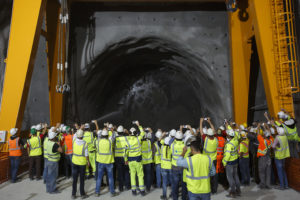 While the TBM did not need to be sealed, the unique machine design took into account a predicted high risk of water inflows. The Crossover XRE machine used a belt conveyor and not a screw conveyor for muck removal, so the muck chute needed to be able to be sealed off in the case of an inrush of water. The bulkhead was thus designed with a large sealing gate just above the belt conveyor. These pressure-relieving gates could also be used in a semi-EPB mode: As the pressure built in the cutting chamber, the gate would then be opened by the pressure, and material would spill onto the belt. As the pressure lowered, the gates would then automatically close, again sealing off the chamber. In extreme cases, the gates could be sealed and the probe/grout drills could be used to drill, grout, and seal off water. Additionally, the gripper shoes and inner telescopic shield were designed with inflatable seals to further protect against inrushes of water.
While the TBM did not need to be sealed, the unique machine design took into account a predicted high risk of water inflows. The Crossover XRE machine used a belt conveyor and not a screw conveyor for muck removal, so the muck chute needed to be able to be sealed off in the case of an inrush of water. The bulkhead was thus designed with a large sealing gate just above the belt conveyor. These pressure-relieving gates could also be used in a semi-EPB mode: As the pressure built in the cutting chamber, the gate would then be opened by the pressure, and material would spill onto the belt. As the pressure lowered, the gates would then automatically close, again sealing off the chamber. In extreme cases, the gates could be sealed and the probe/grout drills could be used to drill, grout, and seal off water. Additionally, the gripper shoes and inner telescopic shield were designed with inflatable seals to further protect against inrushes of water.
With the breakthrough now complete, grouting will continue behind the TBM segments. No additional lining will be added, and the tunnel is expected to become operational by May 2019.
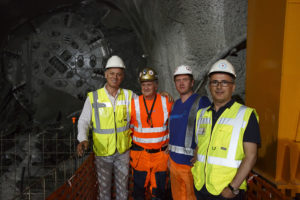 The 6.7 km (4.2 mi) long Moglicë headrace tunnel is part of the Devoll Hydropower Project, a Build-Own-Operate-Transfer (BOOT) scheme to construct two hydropower plants along the Devoll River, named Moglicë and Banja. The project is owned by the Norwegian power company Statkraft AS. The completed Devoll Hydropower Project will increase Albania’s electricity production by 17% and will have an installed capacity of 242 MW.
The 6.7 km (4.2 mi) long Moglicë headrace tunnel is part of the Devoll Hydropower Project, a Build-Own-Operate-Transfer (BOOT) scheme to construct two hydropower plants along the Devoll River, named Moglicë and Banja. The project is owned by the Norwegian power company Statkraft AS. The completed Devoll Hydropower Project will increase Albania’s electricity production by 17% and will have an installed capacity of 242 MW.
Image 1: A 6.2 m (20.3 ft) Robbins Crossover (XRE) TBM broke through at the Moglice Headrace Tunnel in Devoll, Albania on May 3, 2018.
Image 2: The breakthrough of the Robbins Crossover (XRE) TBM marks the completion of the first TBM-driven tunnel in Albania.
Image 3: The TBM bored a 6.7 km (4.2 mi) headrace tunnel for the Devoll Hydropower project, advancing at rates of up to 648 m (2,126 ft) per month.
Image 4: Robbins Field Service personnel assisted contractor Limak throughout the project with guidance and trouble-shooting.
Industry News, trenchless products
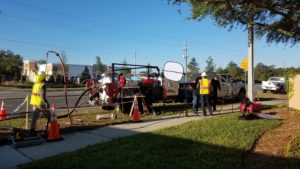 ECHO Utility Engineering and Surveying focuses on a specific aspect of Utility Engineering: Subsurface Utility Engineering.
ECHO Utility Engineering and Surveying focuses on a specific aspect of Utility Engineering: Subsurface Utility Engineering.
Subsurface Utility Engineering (SUE) refers to a branch of engineering that involves managing certain risks associated with utility mapping at appropriate quality levels, utility coordination, utility relocation design and coordination, utility condition assessment, communication of utility data to concerned parties, utility relocation cost estimates, implementation of utility accommodation policies, and utility design.
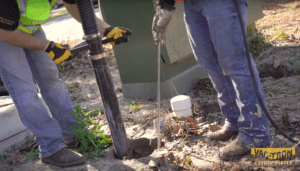 ECHO purchased a Vac-Tron AIR 373 SDT vacuum excavator in 2017 and shared the benefits this unit has created for the company.
ECHO purchased a Vac-Tron AIR 373 SDT vacuum excavator in 2017 and shared the benefits this unit has created for the company.
Project Descriptions
Locating existing subsurface utilities data.
Solution
Vac-Tron Low Profile AIR 373 SDT unit with customized accessories. This unit is powered by an 83 HP Yanmar diesel engine that delivers unmatched power and performance. Hand built in the USA from the ground up including the durable I-Beam trailer assembly. The low profile trailer keeps the components of the unit easily accessible while making the unit safe to tow and a much smoother ride. The AIR unit comes equipped with a hydraulic rear door, which opens fully so the operator can completely empty the contents. For operator safety, the door is controlled by push buttons located on the side of the unit. The AIR unit offers the patented filtration system with 0.5-micron filtration that is unmatched by competitors. It also comes standard with a reverse pressure system and a heavy-duty trailer with Dexter torsion axles.
Results
ECHO has been using the Vac-Tron AIR unit for over a year now. The main efficiency has been getting into tight places and safely onto curbs with the Low Profile unit. “It allows us to get to projects that we normally wouldn’t be able to do,” says President of ECHO UES, Jerry Comellas. “One of the projects we worked on was in a covered garage and if it wasn’t for this unit there is no way we could have accomplished the project because of the low clearances. This was a $48,000 project and is revenue that we wouldn’t have been able to have otherwise.”
“Vac-Tron’s customer service has been outstanding, getting us setup quickly, as our business works really fast, and catering to some of the refinements we made on the unit made it a pleasure to work with Vac-Tron,” Jerry concluded.
Check out the full video interview with ECHO and the unit in action here. For more information on Vac-Tron Equipment and its full fleet of vacuum excavators, please visit them online at www.vactron.com or call 1-352-728-2222.
Industry News, trenchless products
Over 500 water, wastewater and reuse pipeline installations completed
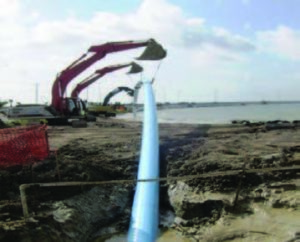 Overview
Overview
Texas municipalities have long been known for their use of trenchless installation methods. Engineers and contractors have been taking advantage of the social and economic benefits of trenchless installation for many years. Until 2004, the primary pipe material used for trenchless applications in water, sewer and water reuse projects was high-density polyethylene (HDPE). With the introduction of Fusible PVC® pipe, owners, design engineers and contractors now have the alternative of a thermally butt-fused PVC pipe system with all of the advantages and familiarity of AWWA C900/C905 PVC pipe. With PVC pipe already widely used in many utility systems, Fusible PVC® pipe allows utilities to maintain material continuity when constructing trenchless installations or direct bury applications requiring a fused thermoplastic pipe system.
A growing list of Texas municipalities and utilities have achieved significant savings by utilizing Fusible PVC® pipe systems while realizing the benefits of a leak-free, fully-restrained, fused PVC pipe system that is easy to maintain. Many municipalities that
have installed Fusible PVC® pipe have become repeat customers and have incorporated the technology into their standard specifications. Whether drilling in clay and sand along the Gulf Coast, or rock formations in North Texas, Fusible PVC® pipe has
demonstrated its ability to handle installation challenges.Over 500 water, wastewater and reuse pipeline installations completed Fusible PVC® pipe offers many advantages that lower overall project and maintenance costs, including:
- Inside diameter (ID) matches the ID of bell-and-spigot PVC pipe, so there is no need to upsize to maintain hydraulics
- Tensile strength of 7,000 psi is 2.5 times higher than the other thermoplastic pipe option
- Superior strength to weight ratio for equivalent ID and pressure class
- Hydrostatic design basis with 2.0 factor of safety
- Standard ductile iron pipe size outside diameter allows seamless connection compatibility with standard ductile iron fittings
Underground Solutions, Inc. provides infrastructure technologies for water, wastewater
and power cable conduit applications. Underground Solutions’ Fusible PVC® pipe
products, including Fusible C-900® pipe, Fusible C-905® pipe and FPVC® pipe, utilize
patented technology to produce a fused monolithic, fully-restrained, gasket-free, leakfree piping system ideal for trenchless (horizontal directional drilling, pipe bursting and sliplining) or conventional “open-cut” installations and are available in 4-inch to 36-inch diameters. The combination of standard fittings and lower weight with higher flow for a given pressure class versus other thermoplastic pipes ensures that Fusible PVC® pipe brings greater economy to most pipeline projects.
Photo: Single HDD pull of 5,545 LF of 18-inch Fusible C-905® pipe in Corpus Christi
Industry News, trenchless people
 The Arab Countries Water Utilities Association (ACWUA), was established in 2009 and has more than 500 individual members and more than 100 water/wastewater utilities from 18 Arab countries.
The Arab Countries Water Utilities Association (ACWUA), was established in 2009 and has more than 500 individual members and more than 100 water/wastewater utilities from 18 Arab countries.
ACWUA will host the Trenchless Arabia Conference and Exhibition on 3-5 March 2019 at King Hussein Bin Talal Convention Centre, Dead Sea, Jordan in conjunction with 5th Arab Water Week. For details, please visit www.trenchlessarabia.com and 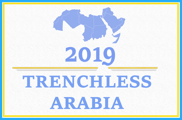 https://aww.acwua.org
https://aww.acwua.org
Trenchless Arabia is an international conference and exhibition promoting condition assessment (cctv inspection and leak detection), ground penetrating radar (gpr), cured in place pipe (cipp) lining, close-fit sliplining, horizontal directional drilling (hdd), pipejacking, pipe bursting, auger boring, microtunnelling and several other trenchless techniques. Rehabilitation or new installation of underground utilities is possible with trenchless techniques which bring crucial advantages such as minimum surface excavation, less environmental damage, shorter construction period and less social cost.
International experts from several institutions, companies and universities will present their best practices and new solutions to the participants from Arab countries. Representatives of ministries, municipalities and utilities from Jordan, Egypt, Lebanon, Palestine, Syria, Iraq, Oman, Bahrain, Yemen, Saudi Arabia, United Arab Emirates (Abu Dhabi, Dubai, Sharjah, Ajman, Umm al-Qaiwain, Ras al-Khaimah and Fujairah), Kuwait, Tunisia, Libya, Algeria, Morocco, Mauritania, Sudan, Qatar, Iran and Turkey will be the key participants. A unique platform will be created among the decision makers, contractors, manufacturers and consultants during the sessions and exhibition.
All NASTT and ISTT members are invited to participate in Trenchless Arabia Conference and Exhibition.
Industry News, trenchless people, trenchless products
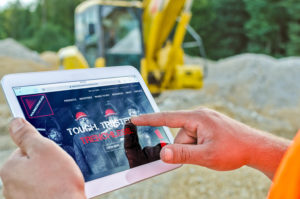
May 7, 2018 – LAKE MILLS, Wisc. – The launch of the newly redesigned HammerHeadTrenchless.com website now gives customers in a wide range of industries even faster, easier access to in-depth information and resources regarding trenchless methods, products and consumables.
Jason Haas, Marketing & e-Commerce Manager at HammerHead Trenchless, a Charles Machine Works Company, said the website redesign was driven by the company’s commitment to providing unsurpassed customer support.
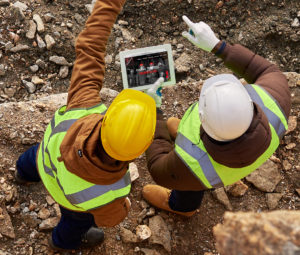 “The focus of our business is always on keeping our customers as productive as possible,” Haas said. “Improving user experience of our website is simply an extension of our dedication to their productivity.”
“The focus of our business is always on keeping our customers as productive as possible,” Haas said. “Improving user experience of our website is simply an extension of our dedication to their productivity.”
Haas said the guiding principle of the redesign was twofold: “We set out to create a site with easy-to-navigate, comprehensive content about trenchless methods and the broad suite of solutions we offer, keeping it as efficient as possible.”
Users of the new site navigate to HammerHead products and educational materials by the trenchless method and the industry served. The site’s responsive design has been optimized for desktop, mobile and tablet devices, so it can be conveniently accessed from any platform, anywhere.
Improved navigation and modern design are not the only changes, however. Additional new features include:
- A dealer Locator tool to quickly find sales, service and contact information
- Enhanced product pages, including updated descriptions, specifications and media galleries
- Links to purchase product on the HammerHeadShop.com e-commerce site
- Industry-specific content that helps users find trenchless solutions matching their unique needs
- Access to the HammerHead resource library containing user manuals, product literature and more
Explore all the new features of the site at www.HammerHeadTrenchless.com.
Industry News
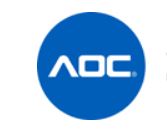 COLLIERVILLE, TENN. – May [2], 2018 – AOC’s parent company, The Alpha Corporation of Collierville, Tennessee, today announced that it signed a definitive agreement with CVC Capital Partners (“CVC”) Fund VI to be acquired. The transaction includes AOC, LLC (“AOC”) the primary asset and wholly owned subsidiary of The Alpha Corporation. The transaction is subject to customary regulatory approvals.
COLLIERVILLE, TENN. – May [2], 2018 – AOC’s parent company, The Alpha Corporation of Collierville, Tennessee, today announced that it signed a definitive agreement with CVC Capital Partners (“CVC”) Fund VI to be acquired. The transaction includes AOC, LLC (“AOC”) the primary asset and wholly owned subsidiary of The Alpha Corporation. The transaction is subject to customary regulatory approvals.
AOC is a leading global producer of resin chemistries for composites and cast polymer applications. Headquartered in Collierville, Tennessee, AOC manufactures polyester and vinyl ester resins, gel coats, colorant dispersions and specialty additives for customers manufacturing products used in the automotive, marine, corrosion, construction and infrastructure segments, among others. The Company has production facilities in the U.S., Canada, Mexico, Europe and Asia.
Upon completion of the transaction, AOC, under the ownership of CVC, plans to work closely with Swiss-based Aliancys, a manufacturer of quality resins and a CVC portfolio company, to create a global leader in the industry. Aliancys’ products are sold to various composites end users in the automotive, building and construction, marine and relining/CIPP sectors.
Said Fred Norman, CEO of AOC, “AOC is excited about the partnership with CVC Capital Partners as the company moves forward on a new path to future growth that will allow AOC to better serve new and existing customers, strengthen our supply chain, and create additional growth opportunities for our suppliers around the world.” Added Norman, “Aliancys has excellent customer relationships and represents a great strategic and complementary fit with AOC as a market leader in global resin chemistries.”
Steven Buyse, Partner at CVC, said: “AOC is an outstanding business with an experienced management team and world class manufacturing facilities. We believe that its combination with Aliancys will create a robust global company with the diverse product mix and exceptional geographic reach to serve markets in every corner of the world. We look forward to working with both AOC and Aliancys and continue to develop high performance composite resins.”
Bert Bakker, CEO of Aliancys, said: “AOC’s business culture is very compatible with that of Aliancys, as they share our commitment to innovation, continuous improvement and customer focus. This is a winning combination for the industry.”
Greenhill & Co. served as exclusive financial advisor to the Board of AOC. Baker Hostetler acted as legal counsel to AOC while Latham & Watkins and Clifford Chance served as counsel to CVC and Aliancys.
About AOC
AOC is a leading global supplier of resin chemistries for polyester and vinyl ester resins, gel coats, colorants, specialty additives and synergistic material systems used in the manufacture of composites parts. Its comprehensive product offering is supported by a global manufacturing and logistics network, which provide customers worldwide with efficient service, customized solutions and complete supply chain management with a focus on customer satisfaction and fulfillment. Headquartered in Collierville, Tennessee, AOC’s products are manufactured at six facilities strategically located in North America and by additional manufacturing locations in Europe and Asia. For more information, please visit: aoc-resins.com
About CVC Capital Partners
CVC Capital Partners is a leading private equity and investment advisory firm. Founded in 1981, CVC today has a network of 23 offices and approximately 400 employees throughout Europe, Asia and the U.S. To date, CVC has secured commitments of over $109 billion from some of the world’s leading institutional investors across its private equity and credit strategies. In total, CVC currently manages over $70 billion of assets. Today, funds managed or advised by CVC are invested in 61 companies worldwide, employing c. 270,000 people in numerous countries. Together, these companies have combined annual sales of over $60 billion. For further information about CVC please visit: www.cvc.com
About Aliancys
Aliancys is a leading global company active in the sales of quality resins for composite applications. Together with its customers, Aliancys is pushing the limits of both composite part manufacturing and performance. Taking an integral approach to new product development, Aliancys is using its full expertise in resin chemistry, material science, and component manufacturing for shaping new applications in composites. The company’s headquarters are based in Schaffhausen, Switzerland, production is located in The Netherlands, France, Italy and China. Aliancys is a joint venture of CVC Capital Partners and Royal DSM. For more information, please visit: aliancys.com
Media Contact
AOC
Fletcher Lindberg
901.854.7235
Flindberg@aoc-resins.com
 On May 3, 2018 a 6.2 m (20.3 ft) diameter Robbins Crossover (XRE) TBM broke through into an underground chamber, marking the completion of the first TBM-driven tunnel in Albania. The TBM, operated by contractor Limak, was also the first Crossover machine to operate in Europe, and bored through geology including ophiolite, sandstone, breccia and siltstone flysch.
On May 3, 2018 a 6.2 m (20.3 ft) diameter Robbins Crossover (XRE) TBM broke through into an underground chamber, marking the completion of the first TBM-driven tunnel in Albania. The TBM, operated by contractor Limak, was also the first Crossover machine to operate in Europe, and bored through geology including ophiolite, sandstone, breccia and siltstone flysch. “The TBM performed very well, as did a Robbins-supplied adit conveyor that operated in a 180-degree continuous curve. It was impressive,” said Max Walker, Robbins Field Service Superintendent. Several field service personnel remained onsite throughout operation of the TBM to provide guidance and trouble-shooting.
“The TBM performed very well, as did a Robbins-supplied adit conveyor that operated in a 180-degree continuous curve. It was impressive,” said Max Walker, Robbins Field Service Superintendent. Several field service personnel remained onsite throughout operation of the TBM to provide guidance and trouble-shooting. While the TBM did not need to be sealed, the unique machine design took into account a predicted high risk of water inflows. The Crossover XRE machine used a belt conveyor and not a screw conveyor for muck removal, so the muck chute needed to be able to be sealed off in the case of an inrush of water. The bulkhead was thus designed with a large sealing gate just above the belt conveyor. These pressure-relieving gates could also be used in a semi-EPB mode: As the pressure built in the cutting chamber, the gate would then be opened by the pressure, and material would spill onto the belt. As the pressure lowered, the gates would then automatically close, again sealing off the chamber. In extreme cases, the gates could be sealed and the probe/grout drills could be used to drill, grout, and seal off water. Additionally, the gripper shoes and inner telescopic shield were designed with inflatable seals to further protect against inrushes of water.
While the TBM did not need to be sealed, the unique machine design took into account a predicted high risk of water inflows. The Crossover XRE machine used a belt conveyor and not a screw conveyor for muck removal, so the muck chute needed to be able to be sealed off in the case of an inrush of water. The bulkhead was thus designed with a large sealing gate just above the belt conveyor. These pressure-relieving gates could also be used in a semi-EPB mode: As the pressure built in the cutting chamber, the gate would then be opened by the pressure, and material would spill onto the belt. As the pressure lowered, the gates would then automatically close, again sealing off the chamber. In extreme cases, the gates could be sealed and the probe/grout drills could be used to drill, grout, and seal off water. Additionally, the gripper shoes and inner telescopic shield were designed with inflatable seals to further protect against inrushes of water. The 6.7 km (4.2 mi) long Moglicë headrace tunnel is part of the Devoll Hydropower Project, a Build-Own-Operate-Transfer (BOOT) scheme to construct two hydropower plants along the Devoll River, named Moglicë and Banja. The project is owned by the Norwegian power company Statkraft AS. The completed Devoll Hydropower Project will increase Albania’s electricity production by 17% and will have an installed capacity of 242 MW.
The 6.7 km (4.2 mi) long Moglicë headrace tunnel is part of the Devoll Hydropower Project, a Build-Own-Operate-Transfer (BOOT) scheme to construct two hydropower plants along the Devoll River, named Moglicë and Banja. The project is owned by the Norwegian power company Statkraft AS. The completed Devoll Hydropower Project will increase Albania’s electricity production by 17% and will have an installed capacity of 242 MW.







